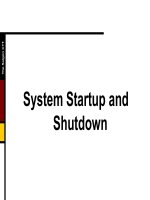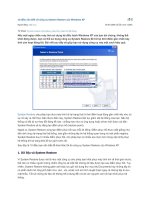digestive system
Bạn đang xem bản rút gọn của tài liệu. Xem và tải ngay bản đầy đủ của tài liệu tại đây (481.51 KB, 33 trang )
DIGESTIVE SYSTEM
DIGESTIVE SYSTEM
Objectives:
-
Identify the organs of the digestive system and list their major
functions. (stomach, small intestine, large intestine and salivary
glands, pancreas, liver, gall bladder)
-
Explain the processes by which materials move through the
digestive tract.
-
Outline the mechanisms that regulate digestion.
The digestive system consists of a muscular tube, the digestive
tract, also called the gastrointestinal tract (GI) or alimentary
canal, and various accessory organs.
The nutrition for the cells of the body must be in a simple
The nutrition for the cells of the body must be in a simple
form: amino acids, simple sugars, and fatty acids.
form: amino acids, simple sugars, and fatty acids.
The digestion process:
The digestion process:
The digestive system takes the
The digestive system takes the
complex organic molecules of the foods we ingest —
complex organic molecules of the foods we ingest —
proteins, carbohydrates, and fats — and break them down
proteins, carbohydrates, and fats — and break them down
into their simple form. The simple molecules (nutrients) are
into their simple form. The simple molecules (nutrients) are
absorbed from the digestive system by the cardiovascular
absorbed from the digestive system by the cardiovascular
and lymphatic systems and transported to cells throughout
and lymphatic systems and transported to cells throughout
the body.
the body.
The digestive system may
The digestive system may
divide into two parts:
divide into two parts:
- A muscular tube, known
- A muscular tube, known
as the alimentary canal or
as the alimentary canal or
digestive tract: the mouth,
digestive tract: the mouth,
pharynx, esophagus,
pharynx, esophagus,
stomach, small intestine, and
stomach, small intestine, and
large intestine.
large intestine.
- The accessory digestive
- The accessory digestive
organs and glands that help
organs and glands that help
in the digestive process
in the digestive process
include the tongue, teeth,
include the tongue, teeth,
salivary glands, pancreas,
salivary glands, pancreas,
liver, and gall bladder.
liver, and gall bladder.
Functions of the Digestive System :
- Ingestion occurs when materials enter the digestive tract via the mouth.
Ingestion is an active process involving conscious choice and decision making.
- Mechanical processing is crushing and shearing that makes materials
easier to propel along the digestive tract. It also increases their surface area,
making them more susceptible to enzymatic attack.
- Digestion refers to the chemical breakdown of food into small organic
fragments suitable for absorption by the digestive epithelium. Simple molecules
in food, such as glucose, can be absorbed intact, but epithelial cells cannot to
absorb molecules the size and complexity of proteins, polysaccharides, or
triglycerides. These molecules must be splitted by digestive enzymes prior to
absorption.
- Secretion is the release of water, acids, enzymes, buffers, and salts by
the epithelium of the digestive tract and by glandular organs.
- Absorption is the movement of organic substrates, electrolytes (inorganic
ions), vitamins, and water across the digestive epithelium and into the
interstitial fluid of the digestive tract.
- Excretion is the removal of waste products from body fluids.
Peristalsis :
- The muscularis externa propels materials from one portion of the
digestive tract to another by contractions knows as peristalsis.
- Peristalsis consists of waves of muscular contractions that move a
bolus, or small oval mass of digestive contents, along the length of the
digestive tract.
- During a peristaltic movement, the circular muscles contract behind
the bolus while circular muscles ahead of the bolus relax. A wave of
contraction in the circular muscles then forces the bolus forward.
Segmentation :
- Most areas of the small intestine and some portions of the large
intestine undergo cycles of contraction that churn and fragment the bolus,
mixing the contents with intestinal secretions.
- This activity, called segmentation, does not follow a set pattern, and
thus does not push materials along the tract in any one direction.
The mouth
The mouth
Food enters the body through the mouth, or oral cavity. The mouth
Food enters the body through the mouth, or oral cavity. The mouth
performs the first step of digestion that is mastication (chewing).
performs the first step of digestion that is mastication (chewing).
Three pair of salivary glands open at various points into the mouth,
Three pair of salivary glands open at various points into the mouth,
about 1 to 2 liters of saliva are secreted each day.
about 1 to 2 liters of saliva are secreted each day.
Sympathetic nerves stimulate saliva production.
Sympathetic nerves stimulate saliva production.
Saliva has many functions :
Saliva has many functions :
- It contains amylase which breaks down polysaccharides (a type of
carbohydrate)
- It contains mucus which moistens and lubricates the food which
helps in swallowing.
- It contains lysozyme which is an anti-bacterial enzyme.
- It helps in the stimulation of the taste buds.
- It aids speech by moistening the lips and tongue.
- It helps keep mouth and teeth clean.
- It buffers acidic foods.
The pharynx:
A common passage way for solid
food, liquids, and air.
Food normally passed through the
oropharynx and laryngopharynx on its
way to the esophagus.
The epithelial lining and regions of
the pharynx – the nasopharynx, the
oropharynx, and laryngopharynx.
The esophagus:
- The esophagus is a hollow
muscular tube with a length of
approximately 25 cm (10 in.) and a
diameter of about 2 cm (0.80 in.) at its
widest point.
- The primary function of the
esophagus is to convey solid food and
liquids to the stomach.
The stomach
The stomach performs 4 major functions :
1) storage of ingested food
2) mechanical breakdown of ingested food
3) disruption of chemical bonds in food material through the action
of acids and enzymes
4) production of intrinsic factor, a glycoprotein whose presence in
the digestive tract is required for the absorption of vitamin B12 in the
small intestine.
+ In an “average” stomach, the lesser
curvature has a length of
approximately 10 cm, and the greater
curvature measures about 40 cm.
+ In the fundus and body of the
stomach, each gastric pit
communicates with several gastric
glands. Gastric glands are dominated
by 2 types of secretory cells :
+ parietal cells: secrete
hydrochloric acid (HCl).
+ chief cells: are more
abundant near the base of a gastric
gland. These cells secrete pepsinogen,
an inactive proenzyme. Pepsinogen is
converted by the acid in the gastric
lumen to pepsin, an active proteolytic
enzyme.









